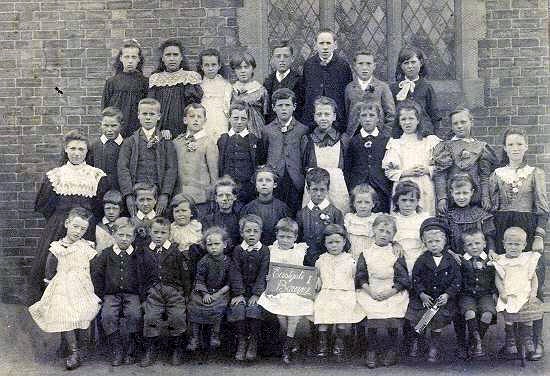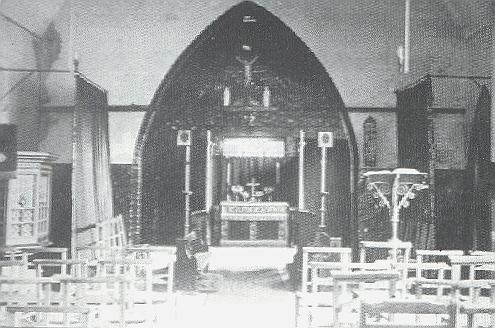The National (mixed) School was built in Willoughby Road in 1857 with classroom space for 200 boys and girls and was responsible for the primary education of children from the Eastgate area. It was designed by the Stamford architect, Edward Browning, who was personally responsible for overseeing the construction.
Arrangements for the establishment of the school began in June 1855 when a subscription list was started to pay for it and sufficient money was raised to negotiate a contract with the builders. Mr John Lely Ostler, one of the town's biggest land and property owners, gave the site and donated £20 towards the cost while the Marquess of Exeter added a subscription of £50. The school was also supported by Harrington's Charity and other voluntary contributions.
Work began in 1856 as reported by the Stamford Mercury on Friday 18th July:
The ceremony of laying the foundation stone of the new school to be built in the Eastgate took place on the afternoon of Thursday the 10th inst. The day fixed for the occasion was the anniversary of the National schoolchildren who at about 3 o'clock went in procession, accompanied by a band of music, from the National school to the site of the new school. After some preliminary observations by the Vicar [the Rev Joseph Dodsworth], coins were placed under the founding stone, and the stone was fixed, the ceremony of "laying the first stone" being performed by Miss Laura Ostler, daughter of J L Ostler, Esq., of Grantham. The Vicar then read a benedictory address to the persons assembled, many of the inhabitants and a great number of children being present. The weather was remarkably fine and a scene of interest and excitement was presented to the minds of many who will not soon forget it. The Vicar, in complimentary terms, took occasion to state that the ground upon which the new school will stand was given for the purpose by J L Ostler, Esq., who replied, and feelingly addressed the parents present upon the importance of education generally, and upon the expediency of their availing themselves of the advantages to be derived by their children from a punctual attendance at this school when opened, which was especially intended for that locality. After three cheers for Mr Ostler, Miss Ostler, the Vicar, and Mrs Dodsworth and the ladies, the company dispersed. The children, to the number of about 200, had their usual treat of cake and tea on the Abbey lawn and afterwards, various amusements and exercises were indulged in. In the evening, about 60 of the inhabitants were entertained at the Abbey.
In 1857, the Bishop of Lincoln, the Rt Rev John Jackson, preached two sermons in the Abbey Church on the subject of education and instructing the young, the proceeds from each collection going towards the cost of the new school. The Stamford Mercury reported on Friday 5th June:
We understand that the school is a most convenient one, built under the superintendence of Mr Browning, and that it affords room for 200 children. The cost has much exceeded the original estimate (not unusual in such matters) and it is intended to make collections for the benefit of the funds at both services.
The total cost was £350 of which £130 remained to be found and the bishop expressed the hope that the congregation would contribute liberally, an opportunity, he said, which was both a privilege and a duty. In the event, the two collections totalled £47 0s. 11d.
The bell in the bellcote at the school came from the Red Hall in Bourne and was given by the Duncomb family who owned it. About this time, they were selling the hall to the Bourne and Essendine Railway Company for use as a railway station for the town and Lady Duncomb, who was by then head of the family following the death of Sir Philip Pauncefoot Duncomb, baronet of Brickhill Manor in Bedfordshire, was persuaded by the Vicar of Bourne, the Rev Joseph Dodsworth, that this relic from the building should go to the school and so it was formally presented to the trustees in March 1860.
Religion played an important role in the life of the school from its inception and in the autumn of 1859, services began on the premises for people living in the vicinity. The Stamford Mercury reported on Friday 18th November:
On Sunday afternoon, the Infant schoolroom was opened for divine service when a large number of persons, composed chiefly of the surrounding poor, attended and filled the building to overflowing. The Vicar [the Rev Joseph Dodsworth] preached the opening sermon, taking for his text John xvii., the 15th verse. In the course of his remarks he observed that on the occasion of the laying of the foundation stone of this very building three years ago, the hopes he then expressed of its being a blessing to themselves as well as to their children were now being realised. The crowded state of the room led him to hope further that he might ere long see the nobler edifice of a church planted in the midst of the populous locality, which was indeed sadly needed. We are informed that a schoolroom service will be shortly commended at the hamlet of Dyke and the school which was supported by the late J L Ostler Esq. [he had died in June 1859] re-opened almost immediately. Thus the church at Bourn is putting forth her best energies and it is hoped that success may attend her efforts.
By 1885, when the mistress was Miss Lucy Ashbrook, the average attendance at the school was 97 and by 1900, there were more than 100 pupils on the roll but despite this popularity, it closed down three years later and the children were sent to the school in Abbey Road.
Apart from religious services, the building was also home to a thriving Sunday School and classes for the study of the bible and other religious subjects were held regularly and were well attended. In 1860, for instance, there were 220 children on the register with 22 voluntary teachers. The running of the school needed funds but all money was donated voluntarily and collections for this purpose were often held at the end of Sunday services at the chapel and in the Abbey Church.
The school closed in 1903 when the remaining pupils were transferred to the board school in Star Lane [now Abbey Road]. The Victorian building then stood empty for two years before re-opening as a full time Anglican mission church serving the Eastgate district and it continued in use for almost half a century. The church closed circa 1950 and was left empty and disused for a spell until leased by the BRM company which used the premises as a steel store for their workshops in Spalding Road. But this too came to end in circa 1960 when the building was demolished to make way for new housing development and the site is now occupied by two bungalows. The fate of the bell from the Red Hall after demolition however is unknown.
Go to: Main Index Villages Index
|


